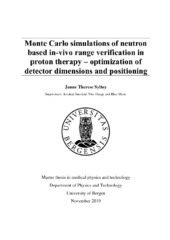| dc.description.abstract | Proton therapy is a cancer treatment modality expanding in clinical applications around the world. Due to the finite range of a monoenergetic proton beam, it is possible to spare more of the healthy tissue surrounding the tumour compared with using traditional radiation therapy with photons. However, this finite range will also make the treatment plan more susceptible to density changes, which will affect the dose delivered to the tumour. To reduce the need for large safety margins in particle therapy and enable proton therapy treatments of patient groups where motion is an issue, there is a substantial ongoing research effort in so-called range verification techniques. Range estimates can be performed in-vivo through the detection of secondary radiation species emitted in nuclear interactions between the incident protons and the nuclei in the patient, such as β+ emitters, prompt gamma-rays, charged fragments and secondary fast neutrons. The objective of this project was to optimize detector dimensions and positioning of an existing detector concept for neutron-based range verifications using Monte Carlo simulations. The MC simulation package FLUKA was used for simulation of four monoenergetic proton beams of typical clinical energies, 100, 160, 200 and 230 MeV, entering a water phantom, and subsequent tracking of the secondary fast neutrons produced in the phantom. In addition, a patient treatment plan for prostate cancer was equivalently evaluated where the primary beam energy ranges from 93 to 197 MeV. The results were processed using python, and the python libraries Matplotlib and NumPy. In order to characterize the position and size of the detector, the neutron detection rate was evaluated for a range of detector sizes and positions. The results showed that the neutron detection rate differed considerably with varying detector position and size, both for the water phantom and the patient treatment plan simulation. As a function of the position of the detector, the rate increased gradually until a peak was reached, followed by an almost symmetric decrease. In relation to the proton beam Bragg peak, the neutron rate peak was generally located close to or distal to the Bragg peak. When the size of the detector was considered, the neutron detection rate increased almost linearly with increasing detector area. The results in this thesis show that the optimal placement of the detector will depend on the specific treatment plan that is to be delivered and should therefore be evaluated for the particular case. With a detector size of 20x20 cm2, using a single position for a broad range of proton energies would lead to a clear reduction in neutron detection rate compared to using multiple positions. The feasibility of moving the detector during treatment should therefore be evaluated for treatment plans with large tumours and target volumes. Alternatively, a larger detector could be applied in order to achieve sufficient neutron detection rate for the energy levels included in the treatment plan. | en_US |
